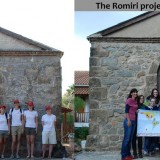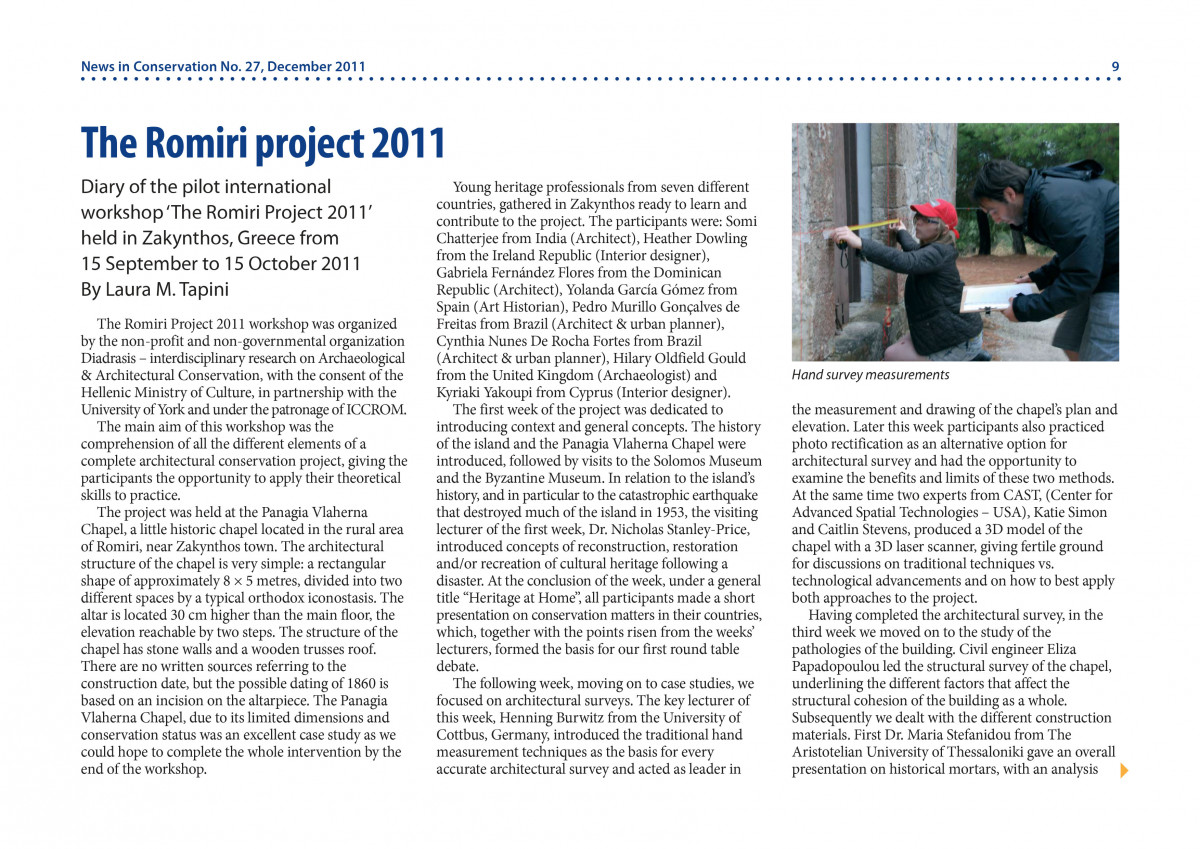The Romiri Project

- Location : Zakynthos, Greece
- Date: 2011
- Participating Countries : BRAZIL, CYPRUS,DOMINICAN REPUBLIC, INDIA, IRELAND, SPAIN, UNITED KINGDOM
- Partner Institutions : ICCROM, University of York, Hellenic Ministry of Culture, Directorate for Conservation of Antiquities, Hellenic Ministry of Culture, 20th Ephorate of Byzantine Antiquities
The project
The "Romiri project" is a pilot international workshop for graduates and young professionals of Heritage Sciences. It will be held in September 2011 in Zakynthos, Greece, on the historic chapel of "Panagia Vlaherna". The main aim of this project is the comprehension of all the different tasks of a complete architectural conservation project. The Romiri project is structured on the basis of a complete project, giving the participants the opportunity to apply the theoretical skills in action. Due to the limited dimensions of the church, all actions regarding the architectural elements, from planning to conservation treatment, can be completed by the end of the workshop, resulting in this manner in a small scale model of the normal procedures of a complete conservation plan.Contents
The program of the workshop is structured as follows: Lectures, Laboratories (Technical exercises and Data processing), Field exercises, Discussions & Presentations, focused on the workshops case study. It will also include side activities like visits to other areas of the Island and one excursion to ancient Olympia.
All the above-described activities will alternate, in accordance with the needs of the subject covered every week.
Week 0: Context, Concepts, General Methodology
Introductory week, including a short presentation of the island’s history and an overview of concepts and general practices of conservation projects.
Week 1 Survey week:
Introduction to the project and to the importance of observation and preliminary studies before action. The main themes will be the survey introducing instruments and methods, and the documentation as a tool for conservation. By the end of the week, a complete survey of the architectural elements must be produced, which will be the working base for the following weeks.
Week 2 Masonry Stone pathology :
The second week will begin with a static analysis to be followed by the analysis of single elements and the pathologies of stone masonry. Subsequently following the decay mapping we will move on to the first conservation intervention tests in situ. By the end of week two, the strategy of intervention must have been planned and the intervention began.
Week 3 Field exercise week:
The third week is completely dedicated to the hands-on conservation experience. At the same time, the participants will be given guidelines for the appropriate way of documenting conservation works. By the end of this week, the intervention must be completed and the relative documentation report produced.
Week 4 Planning future activities and dissemination
The fourth week focuses on the sustainability of the project. That is, planning future conservation treatments according to the observations made during the previous studies and hands-on experience of preparing a conservation project. The final step will be to create a dissemination project.
Lecturers
- Henning BURWITZ ,Architect (Germany), Lehrstuhl Baugeschichte, Brandenburgische Technische, Universität Cottbus.
- Katerina EFTHIMIOU, Conservator of Antiquities and Works of Art (Greece), Hellenic Ministry of Culture and Tourism, Directorate of Conservation of Ancient and Modern Monuments.
- Lucía GÓMEZ‐ROBLES, Architect and Art Historian (Spain)
- Dr. Peter GOULDSBOROUGH, Architect (UK) MA, D.Phil. University of York, former director of Studies, Centre for Conservation Studies, The University of York. Joseph KING, Architect (USA) Unit Director, Sites Unit, ICCROM.
- Maria KRINI, Conservator of Antiquities and Works of Art (Greece), Hellenic Ministry of Culture and Tourism, Directorate of Conservation of Ancient and Modern Monuments.
- Pablo LATORRE, Architect (Spain) Caja Madrid Foundation.
- Eliza PAPADOPOULOU, Civil Engineer (Greece)
- Dr. Ioannis POULIOS, Archaeologist, Heritage consultant, (Greece University of Western Greece; Greek Open University.
- Katie SIMON, 3D Scanning Specialist (USA) Center for Advanced Spatial Technologies.
- Dr. Nicholas STANLEY‐PRICE, Archaeologist (UK). MA, D. Phil. Oxford University, former ICCROM director.
- Maria STEFANIDOU, Civil Engineer (Greece) Assistant Professor, Civil Engineering Department AUTH, School of Engineering, Aristotle University of Thessaloniki.
- Caitlin STEVENS, Building Information Systems Coordinator (USA) Center for Advanced Spatial Technologies.
- Laura‐Melpomeni TAPINI, Conservator (Greece) ΜΑ (Hons) Conservation Studies ‐ University of York.


